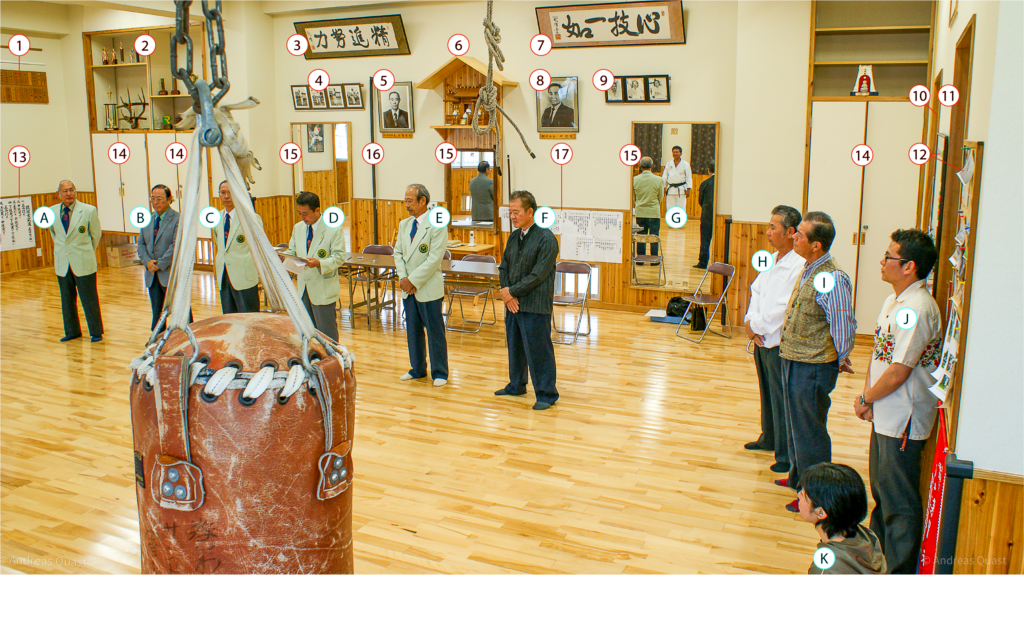I have been digging into architecture and interior design of dojo in Okinawa and how they came about. The modern dojo is certainly a postwar invention but you can see it go back to the 1939 Butokuden, and even to the school gyms at the Normal school, which already had a calligraphy of Kano Jigoro’s motto on its wall. There were also Butokuden in colonies of Japan, such as in Taiwan, were any Okinawans served during the war years from the 1930s to 1945, and even Yaeyama had a Butokuden.
I am not going into detail here but simply speaking, prewar school gyms as well as judo dojo, students visiting Kyoto Butokuden and Kodokan since 1908, police dojo (= full fledged multipurpose gyms), the several Butokuden in Taiwan since the 1900s, the Yaeyama Butokuden in the 1930s, the Naha Butokuden 1939, and so on.
After the war, Nagamine (Matsu), Higa (Kyudokan), Miyahira (Shidokan) and others opened full-fledged dojo with wooden floors, calligraphies, weapons, hojo undo equipment, Western training devices, Makiwara, Nafudakake, alcoves, etc.pp. locker rooms and showers, socializing area etc. and a dojo sign outside.
These dojo in turn influenced othered who followed suit.
Like this, the Okinawan dojo was born in the postwar era.
It is characterized by a mix of formality, spirituality, utility, and personal tradition, and it is often highly personalised by memorabilia, photos, and lineage charts and also includes Okinawa-specific items such as Shisa, folk beliefs, religion etc.pp.
It took inspiration along the way and since Japan is the country of budo, it is clear that seeing other dojo influenced the Okinawans as well, such as municipal Budokan and prefectural and national Budokan.
As most other people, I have only certain “windows” to compare. While I received a lot of details from friends and colleagues about the founding year and interior design of dojo etc., I use the Shimbukan as a reference here simply because I have made good quality photos myself.
What do you think about interior dojo design in Okinawa?
Photo: Scenery of Dan grading (4th and 5th Dan), May 15, 2011, 04:08pm. Location. Shimbukan, Tomigusuku, Okinawa.
1. Name tag board (nafudakake, showing name and rank)
2. Cabinet with memorabilia (trophies etc.)
3. Four-character idiomatic phrase “Devotion and Effort”
4. Photos of elders (Higa Seiichirō, Higa Raisuke, Higa Jinsaburō, Akamine Yōei)
5. Photo of Akamine Eisuke (founder of Shimbukan)
6. House altar (kamidama)
7. Four-character idiomatic phrase “Spirit and Technique in Unity”
8. Photo of Taira Shinken (founder of Ryūkyū Kobudō Hozon Shinkōkai)
9. Photos of Mabuni Kenwa (founder of Shitō-ryū), Funakoshi Gichin (founder of Shōtōkan-ryū), and Yabiku Mōden (prewar kobujutsu master)
10. Entry door
11. Door to social area
12. Calendar and photo wall
13. Bō Kihon: numbers and names
14. Weapons cabinet
15. Mirror
16. Nagabō in protective case
17. Karate list of kihon names etc.
A. Chinen San (Gave me a bike, teice!)
B. Miyagi San (wouldn’t teach me Kōjo no Sai)
C. Akamine Hiroshi San (Director of the Shimbukan)
D. Kuniyoshi Yukio San (former instructor of Shimbukan, now President of Ryūkyū Kobudō Hozon Shinkōkai)
E. Yoshimoto Kagemasa San (senior member Shimbukan)
F. Shiroma Katsuo San (Ryūkyū Kobudō person, teacher of my first teacher)
G. Arakaki Takashi San (tested for 5th dan kobudo)
H. Yosa Masao San (former instructor of Shimbukan since the 1970s, does not have a dōjō so he’s vacant)
I. ?
J. ?
K. ? (student of Kuniyoshi San)
© 2023 – 2024, Andreas Quast. All rights reserved.

